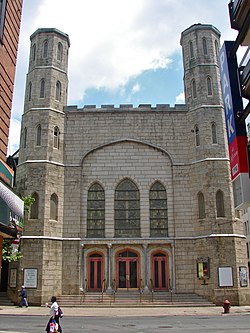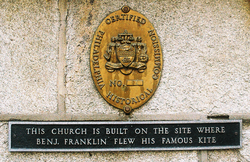
St. Mary's Episcopal Church is a historic Episcopal parish in Burlington, Burlington County, New Jersey, United States. The original church was built in 1703. It was supplemented with a new church on adjacent land in 1854. On May 31, 1972, the new church was added to the National Register of Historic Places and on June 24, 1986, it was declared a National Historic Landmark. It is within the Burlington Historic District.

Christ Church is an Episcopal church in the Old City neighborhood of Philadelphia. Founded in 1695 as a parish of the Church of England, it played an integral role in the founding of the Protestant Episcopal Church in the United States. In 1785, its rector, William White, became the first Presiding Bishop of the Episcopal Church.

St. Peter's Church is a historic Episcopal church located on the corner of Third and Pine Streets in Philadelphia, Pennsylvania. It opened for worship on September 4, 1761 and served as a place of worship for many of the United States Founding Fathers during the period of the Continental Congresses. The building was designated a National Historic Landmark in 1996. The church remains an active parish; the current priest-in-charge is the Rev. Dr. Clarke French.
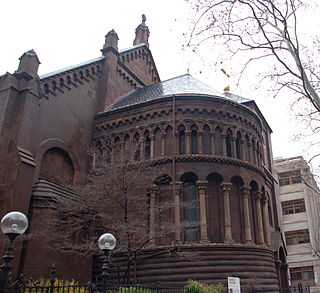
Saint Clement's Church is an historic Anglo-Catholic parish in Logan Square, Center City, Philadelphia. It is part of the Episcopal Diocese of Pennsylvania. The church, designed by architect John Notman, was built in 1856. It originally incorporated a spire more than 200 feet (61 m) tall; this was found to be too heavy for the foundation and was removed in 1869. In 1929, the church building, which includes the parish house and rectory, and weighs 5000 tons, was lifted onto steel rollers and moved forty feet west to allow for the widening of 20th Street. On November 20, 1970, Saint Clement's Church was listed on the National Register of Historic Places.

The Church of St. James the Less is a historic Episcopal church in Philadelphia, Pennsylvania, that was architecturally influential. As St. James-the-Less Episcopal Church, it was designated a National Historic Landmark for its Gothic Revival architecture, which influenced a generation of subsequent churches.
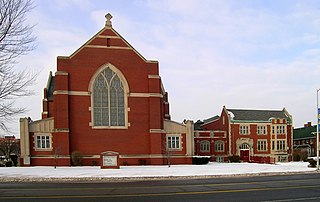
The St. John's Christian Methodist Episcopal Church is a church located in Detroit, Michigan. It was built as the North Woodward Congregational Church, listed on the National Register of Historic Places in 1982, and designated a Michigan State Historic Site in 1998.

All Saints Church is an historic Episcopal church located at 51 Concord Street in Peterborough, New Hampshire, in the United States. Completed in 1914, it is a completely realized example of an English country church as interpreted by the architect Ralph Adams Cram. On December 1, 1980, it was added to the National Register of Historic Places.

Trinity Episcopal Church is a historic church in Mobile, Alabama, United States. It was the first large Gothic Revival church built in Alabama. The building was designed by architects Frank Wills and Henry Dudley.
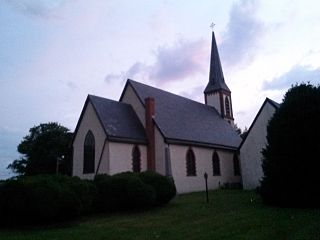
St. Stephen's Episcopal Church is a historic Episcopal church located in Earleville, Cecil County, Maryland.
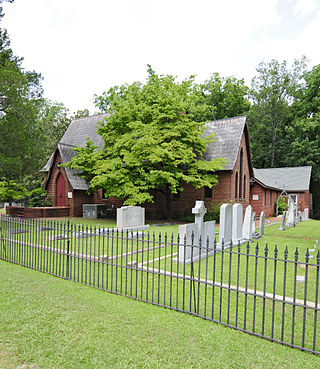
St. Stephen's Episcopal Church is an historic Episcopal church building located northeast of Ridgeway, South Carolina, on County Road 106. Built of wood in 1854 in the Carpenter Gothic style, it was designed by the Rev. John Dewitt McCollough, who later became its rector. The exterior was painted a maroon color. In 1920, its exterior wood was covered by brick veneer, so that it appears today as a brick Gothic Revival style building on the outside while the interior retains its Carpenter Gothic features. A wing was added in the 1940s to create space for a parish hall and Sunday school.

Holy Trinity Episcopal Church also known as Holy Trinity Memorial Church is an historic Episcopal church building located at 38 Grand Avenue in the village of Swanton, Franklin County, Vermont. Built in 1876 and expanded in 1909-10, the church facilities include a fine example of the Carpenter Gothic in the older section, and the Late Victorian Gothic Revival in the newer section. The church was listed on the National Register of Historic Places as the Parish of the Holy Trinity in 2001. The church is an active parish in the Episcopal Diocese of Vermont; its current rector is the Rev. Reid D. Farrell.
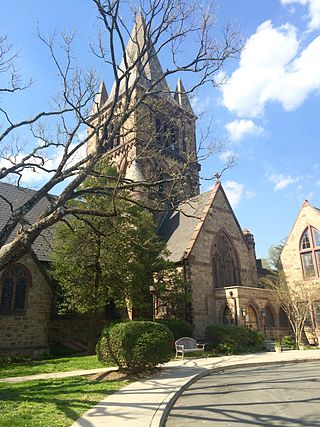
Trinity Church is a historic Episcopal congregation located at 33 Mercer Street in Princeton, New Jersey. It is the largest Episcopal church in New Jersey.

Trinity Episcopal Church is a historic Episcopal congregation and church, designed by Toledo, Ohio architect Charles Crosby Miller and constructed ca. 1865 in Fort Wayne, Indiana. The congregation was organized in 1839 as Christ Church and the name changed in 1844 to Trinity Church. The first church was built on the southeast corner of Berry and Harrison Streets in 1848. It is an example of Gothic Revival architecture.

St. Paul's Episcopal Church is a historic Episcopal church at Old York and Ashbourne Roads in Elkins Park, Cheltenham Township, Montgomery County, Pennsylvania. It was originally built in 1861, and is a gray stone church in the Gothic style. The church was conceived by noted financier Jay Cooke (1821–1905), along with John W. Thomas, J.F. Peniston and William C. Houston. Its size was doubled with an expansion in 1870, and a 60-foot-tall tower added. A transept was added in 1883, and the two-story parish hall wing in 1891. Architect Horace Trumbauer (1868–1938) made some refinements to the church during the 1897 to 1924 period. The main sanctuary of the church features 13 stained glass windows from Tiffany studios.

Wesley A.M.E. Zion Church is an historic church, which is located at 1500 Lombard Street in Philadelphia, Pennsylvania. Added to the National Register of Historic Places in 1978, it also appears in the Philadelphia Register of Historic Places and the Pennsylvania State Historic Resource survey.

St. Paul's Episcopal Church, Exton, also known as St. Paul's Church, is a historic church at 1105 E. Lincoln Highway in Exton, Pennsylvania in Chester County, Pennsylvania, in the area known as the Great Valley. It was built in 1828 and added to the National Register of Historic Places in 1984 as St. Paul's Church. It is one of the 155 parish churches of the Episcopal Diocese of Pennsylvania.

Trinity Episcopal Church is a parish church in the Episcopal Diocese of Iowa. The church is located in Iowa City, Iowa, United States. It was individually listed on the National Register of Historic Places in 1974. In 2021, the building was included as a contributing property in the Iowa City Downtown Historic District.
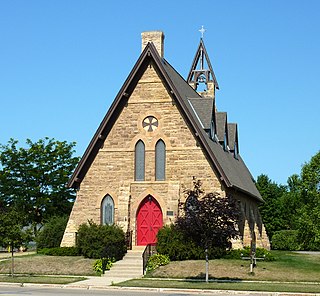
The Church of the Holy Communion is an historic stone Episcopal church building located at 116 North Minnesota Avenue St. Peter, Minnesota, United States. Designed by noted ecclesiastical architect Henry Martyn Congdon of New York City in the Gothic Revival style of architecture, it was built in 1869 of Kasota limestone. It features buttresses and a steeply sloping gabled roof with smaller gabled eye-windows on each slope of the roof. On May 19, 1983, the building was added to the National Register of Historic Places.

The St. Mary's Episcopal Church in Franklin, Louisiana, United States, is a historic church at 805 1st Street. Designed by New Orleans architect James Freret for R.W. Micou, it was advertised by the Lhote Lumber Company in its 1883 Buyers' Guide.
St. David's Episcopal Church is a parish of the Episcopal Diocese of Pennsylvania in the Manayunk neighborhood of Philadelphia, Pennsylvania. It is part of the Wissahickon Deanery of the Diocese of Pennsylvania. In 1960, the parish reported 621 members; it reported 37 members in 2019. English-born mill-workers were heavily represented in its early population, while mill owners were successive wardens, vestrymen, and treasurers.
